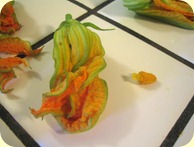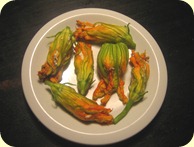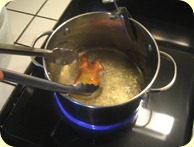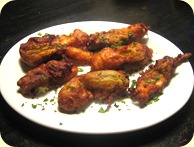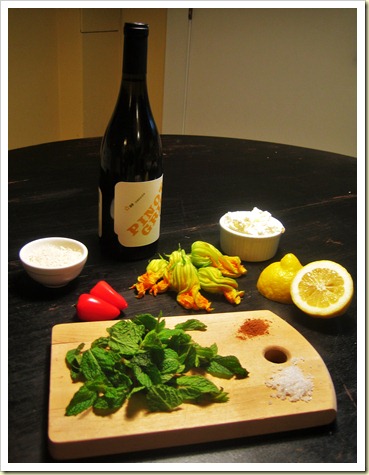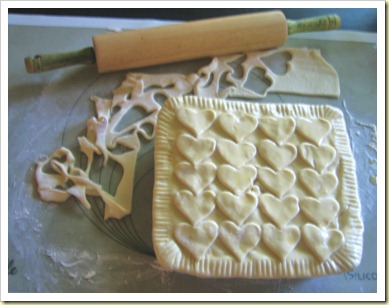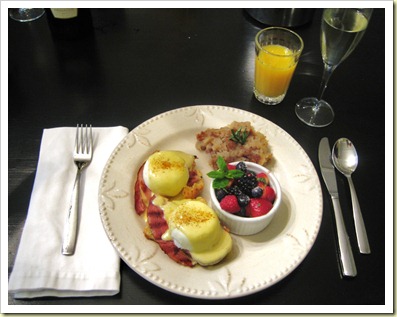
Saturday is brunch day at our house.
There are three rotating brunch menus from which I rarely stray. Whole wheat buttermilk pancakes and Great Aunt Vi’s golden butter waffles are par for the course. When feeling ambitious, I might whip up crepes with assorted fillings, including ham and gruyere, mushroom béchamel, lemon and sugar, nutella with strawberries, nutella with bananas and whipped cream… Essentially, crepes are a thinly veiled excuse to justify nutella consumption.
Although my family was perfectly happy with my ‘repertoire a trois’, I decided that it was time for something new.
I have always loved Eggs Benedict but had never before attempted to make them at home. Last fall, I was inspired by a version at the darling restaurant, Jen’s Garden, while visiting my mom, in Sisters, Oregon. It was by far the best interpretation I have encountered and I intended do my best to replicate it.

Rather than the traditional english muffin, I baked rosemary parmesan scones, modified from a recipe for a cheddar chive version. I cut half the dough into triangles and the other half into circles. The triangular scones came out better and provided a better visual contrast to the roundness of the poached eggs.
I recently discovered a flavorful, smoked ham at Bill the Butcher, the new neighborhood butcher shop, in Madison Valley. I grilled 1/4” slices of ham using my All-Clad grill pan, which makes authentic-looking grill lines on whatever you cook in it. I love this pan for burgers and sandwiches, as well.
From the deep recesses of a kitchen cupboard, I retrieved my fancy, underused Belgian egg poacher, from Sur la Table. One of our friends, who is a chef, mocked the ridiculousness of my having an egg poacher when it is apparently quite simple to poach eggs without one. I admit, the final result ended up looking like something you would get from room service at a fancy hotel. Not exactly rustic cuisine but pretty. I used local, organic eggs from Stiebrs Farms.
For the hollandaise, I decided that Julia Child’s recipe in ‘The Way To Cook’ was the way to go. I was terribly nervous about cooking the egg yolk and curdling the sauce but tried to remain calm as I whisked the eggs, lemon and butter into an emulsion. Julia Child’s recipe has a stopping point at which you can chill the mixture and then add in the remaining butter when you are ready to use the sauce. This was a great time saver and had no adverse affect on the finished product. In fact, it came out beautifully and tasted as good as any I’ve had in a restaurant. One suggestion that worked to keep the sauce from becoming too thick was to add 1-2 ice cubes while warming it on the burner. For seasoning, I used white pepper to avoid those pesky black flecks in the pale yellow sauce.
After splitting the scones in half, I placed grilled slices of ham on the halves and then perched the poached eggs atop the ham. The eggs were blanketed with hollandaise and a delicate dusting of paprika. They were postively picture perfect.
Organic strawberries, blackberries, blueberries and raspberries were mixed with fresh squeezed lime juice, a touch of superfine sugar and a sprinkle of fragrant chopped mint. I am not a fan of flavors mingling on my plate unless they were intended to and the brulee cups were the ideal solution.
Using a vintage French Mouli shredder, I shredded organic russet potatoes for hash browns. You can’t hurry hash browns, which I did, by turning them too often and using the wrong pan. The crispy brown part that was supposed to make them hash browns, as opposed to just ‘hash’, would not budge from the bottom of the pan. In the end, they were alright; but decidedly more of a cross between hash browns and mashed potatoes. I called them ‘mash browns’. I may be on to something…
I found that the trickiest part was keeping everything warm while assembling each of the plates. With guests joining us for brunch, I was frantically trying to get five plates ready at the same time. This is precisely why they put everything under a warmer in restaurants.
Brunch is a great excuse to drink in the middle of the day. With this meal, I served our favorite Prosecco, called Jeio.
The eggs benedict were delicious and a welcome departure from the typical Saturday fare but they were also a lot of work. Next Saturday, it’s pancakes and bacon, all the way.
